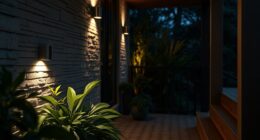Tactile and contrast cues are key tools that help you navigate environments safely and independently. Tactile cues, like textured flooring and raised surfaces, give physical feedback about your surroundings, while contrast cues highlight important features through color and brightness differences. Together, these cues help you recognize pathways, hazards, and key locations more easily. Understanding how these cues work can make your travel more confident—continue exploring to learn more ways they support your navigation.
Key Takeaways
- Tactile cues, like textured flooring and raised patterns, provide physical feedback to help low-vision users navigate environments safely.
- Contrast cues use color and brightness differences to highlight key features and boundaries, improving visibility and recognition.
- Combining tactile and contrast cues in design creates layered guidance, enhancing spatial awareness and independence.
- Well-designed tactile and contrast features reduce confusion and support safe, confident movement in unfamiliar or complex spaces.
- Thoughtful integration of these cues empowers individuals with low vision to navigate environments more autonomously and safely.

Have you ever wondered how people with low vision traverse unfamiliar environments? It’s a question that highlights the importance of tactile and contrast cues, which serve as vital tools for safety and independence. When you can’t rely fully on sight, these cues become your guiding lights, helping you recognize pathways, identify key locations, and avoid hazards. They are deliberately designed features that work together to create a more navigable world for those with limited vision.
Tactile cues are essential for providing physical feedback about your surroundings. Raised surfaces, textured flooring, and tactile paving are common examples. Imagine approaching a busy street corner; the textured tiles underfoot alert you that you’ve reached a crossing point. These tactile indicators often come in specific patterns, such as truncated domes, which signal the boundary between a sidewalk and a roadway. By feeling these textures beneath your feet or your cane, you gain crucial information about your location, direction, and upcoming changes in the environment. This tactile feedback helps you confirm your position, plan your next move, and stay oriented without visual cues. Additionally, environmental design plays a key role in integrating tactile cues effectively into public spaces.
Contrast cues complement tactile information by making key features more distinguishable through color and brightness differences. High contrast between surfaces, signs, and architectural elements ensures that you can quickly identify important features even if you can see only a small part of them. For example, a door painted in a dark hue against a light-colored wall makes it stand out clearly, or a handrail painted in a bold color against a neutral background provides a visual anchor. These contrast cues work together with tactile cues by reinforcing recognition and orientation, making it easier to find entrances, stairs, elevators, or other critical points. When combined, they create a layered system of guidance that enhances spatial awareness.
Designers and urban planners recognize that integrating tactile and contrast cues is fundamental to accessible wayfinding. They incorporate textured surfaces at crossings and along pathways, along with contrasting colors and patterns that highlight important features. As someone traversing these environments, you benefit from this thoughtful design, which reduces confusion and increases confidence. The seamless integration of tactile and contrast cues transforms complex or unfamiliar settings into spaces you can interpret and navigate independently. This approach empowers you to move safely, confidently, and with greater autonomy, demonstrating how thoughtfully designed environments can support those with low vision in everyday life.
Frequently Asked Questions
How Do Tactile Cues Differ From Auditory Cues in Wayfinding?
Tactile cues involve physical sensations you can feel, like textured paving or braille signs, helping you navigate safely. Auditory cues, on the other hand, rely on sounds, such as street crossings with sound signals or ambient noise, to guide you. While tactile cues provide direct, touch-based information, auditory cues offer environmental awareness through hearing. Both work together to improve your wayfinding, but they engage different senses for navigation.
Are There Specific Materials Best for Tactile Paving?
You should choose tactile paving materials like raised concrete, rubber, or metal with textured surfaces, as they provide clear, durable, and slip-resistant cues. These materials are easy to maintain and withstand weather conditions, ensuring long-term effectiveness. Opt for high-contrast colors to enhance visibility for those with limited vision. Proper installation and consistent patterns help users reliably identify key areas, improving overall safety and navigation.
How Can Contrast Cues Be Customized for Individual Needs?
You can customize contrast cues by choosing colors that stand out against their surroundings and adjusting lighting conditions. Use high-contrast combinations like yellow on black or white on dark backgrounds. Consider individual needs—some may favor brighter or more vivid colors. You can also incorporate tactile markers alongside visual cues for a thorough approach. Regular assessments help guarantee these cues remain effective as needs evolve, making navigation safer and more accessible for everyone.
What Are the Latest Technological Advancements in Low-Vision Wayfinding?
You can now use smartphone apps with GPS and augmented reality features to navigate more effectively. Wearable devices like smart glasses provide real-time auditory cues and tactile feedback, guiding you around obstacles. Advanced indoor navigation systems employ Bluetooth beacons and Wi-Fi signals for precise location tracking. These innovations make wayfinding more accessible, personalized, and seamless, helping you move confidently in unfamiliar environments.
How Do Environmental Factors Affect Tactile and Contrast Cue Effectiveness?
Environmental factors can surprisingly sabotage tactile and contrast cues. You might think textured surfaces and bold colors always guide you, but rain, dirt, or poor lighting can wash out tactile signals and dull contrast. Wind can even shift tactile markers, making them harder to feel. So, in the chaos of real life, these cues often don’t work as perfectly as you’d hope, forcing you to rely on multiple aids.
Conclusion
By incorporating tactile and contrast cues into your environment, you can significantly improve wayfinding for individuals with low vision. These cues help create safer, more accessible spaces, empowering users to navigate confidently. Remarkably, studies show that over 70% of low-vision individuals rely heavily on tactile cues for orientation. Embracing these simple yet effective strategies not only enhances independence but also fosters inclusive communities where everyone can move freely and safely.









